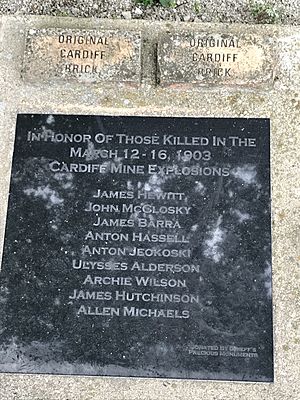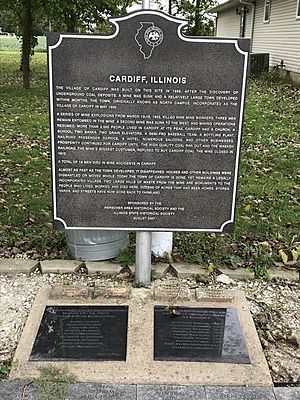Cardiff, Illinois facts for kids
Cardiff is a ghost town in Livingston County, Illinois, United States. It was once a busy place built around a coal mine in 1899. The town grew quickly in its first few years. However, when the mine closed in 1912, the community soon disappeared. Cardiff is located in Round Grove Township, between the villages of Campus and Reddick.
Contents
How Cardiff Began
Before Cardiff became a town, the area was farmland known as Collopy's Corners. It belonged to Patrick Collopy and his wife Ann. They bought their first piece of land there in April 1899. The spot that would become the main streets of Cardiff was simply "the corners."
The White Breast Fuel Coal Company arrived in 1899. They wanted to start a coal mine near the village of Campus. When some people in Campus didn't want the mine there, the coal company bought land from Patrick Collopy instead in May 1899.
Work on the new mine started on May 6, 1899. Coal was found about 250 feet deep. The coal company created a new branch called the Campus Coal Co. For the first four months of 1899, the area was called North Campus.
Fred E. Ahern, who owned land next to the mine, quickly saw a chance to make money. By the end of 1899, he was selling plots of land in the new town. He also built one of the first houses.
The mine was built in the first half of 1899. In June, miners began digging out rock and clay. A railroad track was built from the Wabash Railroad in Campus, stretching two miles north to the mine.
On September 1, 1899, the town was officially named Cardiff. It was named after Cardiff, Wales, which was a very rich coal mining area in the world. The company's name also changed to the Cardiff Coal Company. By mid-September, coal was being sent to Dwight, Illinois. About 175 to 200 people were working in Cardiff.
Growing Pains and Early Life
Cardiff's large grain elevator opened on October 2, 1899. Farmers lined up for a quarter mile in every direction to bring their grain there.
By mid-October 1899, the mine was producing 50 tons of coal each day. This increased to 100 tons by November and 200 tons by December. Miners from nearby towns like Braceville, Clarke City, and Coal City came to work in Cardiff.
Many homes were quickly built for the workers. The Hotel DeWelcome opened on the north side of town. In 1900, the Hotel Cardiff also opened. One of the biggest stores was the Livingston Supply Co., which was the company store.
A schoolhouse was finished in December 1899. Miss Bronson was hired as the teacher, and about 40 children started school in January 1900. The first church service also began in January. Reverend Brothers from Reddick started preaching and teaching Sunday School in the new schoolhouse.
The village of Cardiff officially became a town on Thursday, May 24, 1900. The first election was held on June 19, 1900, and Frank Milem was elected mayor.
The Schlitz Brewing Co. had a big presence in Cardiff. They built a cold storage building in 1900. In 1902, they built another building for selling beer. By 1904, Schlitz built a two-story building. It was advertised as one of the best saloons between Chicago and St. Louis.
Disaster and Rebuilding
As the mine grew into a big business, the village continued to expand. By January 1903, there were 400 miners. They were bringing up 1,200 to 1,600 tons of coal every day. The company still couldn't meet the high demand for its coal. The village had a population of over 2,000 people.
Then, a terrible event happened. Around midnight on Thursday, March 12, 1903, an explosion in the mine occurred. A huge blast of air pushed three miners against the shaft wall, killing them. The explosion shook the town and woke up most residents. Flames and debris shot more than 100 feet into the air from the mine opening.
Rescuers worked hard and were able to bring out the dead and injured miners by early Friday morning.
On that same Sunday morning, a team of six men was in the mine cleaning up from the first explosion. Shortly after the funerals for the first victims, a second mine explosion happened. Five of the six men working were killed.
A third explosion happened on Monday, just before another crew was about to go in for repairs. This was the biggest blast of the three. It blew out the top of the mine shaft and damaged machinery. The company carpenter, Allen Michaels, was looking down the shaft when it exploded and was killed.
Two more explosions happened over the next couple of days. No one else was hurt in those. In total, nine people died and thirteen were injured in the five explosions. The cause of the explosions was never fully known, but it was likely due to gas in the mine.
The mine was completely destroyed. The company estimated its loss at $100,000. It looked like this disaster would mean the end for Cardiff.
However, soon after the explosions, the Cardiff Coal Co. announced they would dig a new mine shaft nearby. Work began in April 1903. The first coal from the new mine was brought up on Sunday, June 7, 1903.
Peak Years and Decline
Within a few years, Cardiff grew even larger. The mine employed about 500 miners. The town's population was estimated to be between 2,000 and 2,500 people. Cardiff had two banks, two grain elevators, a soft-drink bottling plant, a candy factory, and at least two dance halls. There were many businesses, including clothing stores, meat markets, bakeries, barber shops, and general stores. It even had an automobile dealership when cars were still very new.
The town had a modern water system, a gas system, and an electric light plant. There was a railroad station and two train lines with passenger service. Cardiff also had a first-class hotel with good food, a doctor's office, and a post office.
The mine and Cardiff were at their busiest in 1907 and 1908. In 1907, a total of 216,781 tons of coal were mined. In 1908, 216,987 tons were mined.
Then, a different kind of problem arose. In 1910, the Wabash Railroad, which bought most of Cardiff Coal Co.'s coal, announced it would no longer buy coal from Cardiff. The quality of the coal had gotten worse and no longer met the railroad's needs for its steam engines. Without the Wabash Railroad, the mine lost a lot of money. It soon became clear that the mine would have to close.
The Cardiff mine officially closed on September 21, 1912. People quickly left the town, and most of the remaining businesses closed down. Many of the houses were taken apart and moved to nearby towns and farms, where they were put back together. The Cardiff Coal Company's property was sold at a public auction on September 2, 1916.
By 1920, the population of Cardiff had dropped to just 152 people. In 1927, the telephone book listed only two businesses and three people with telephones.
Cardiff Today
In 1983, a state project worked to clean up the old mine site. They used the "slack" (a mix of coal fragments, coal dust, and dirt left after mining) from the large waste hill to fill in the mine shafts. The concrete supports at the mine site were also removed. There were two ponds where coal was washed, but these have mostly been filled in and are now covered with plants.
Today, all that remains of Cardiff are a few broken sidewalks. You can also see the large hill of waste from the second mine and a smaller hill above the first mine. Only a few houses and trailers are left along a rural road in the area. What was once the busy town of Cardiff is now mostly gone.



